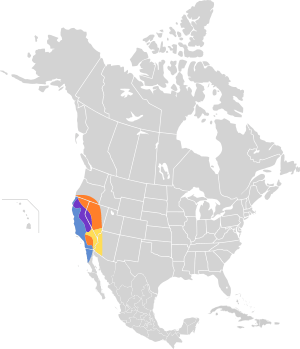Thick-billed fox sparrow facts for kids
Quick facts for kids Passerella iliaca megarhyncha |
|
|---|---|
 |
|
| Scientific classification |
|
| Kingdom: | Animalia |
| Phylum: | Chordata |
| Class: | Aves |
| Order: | Passeriformes |
| Family: | Passerellidae |
| Genus: | Passerella |
| Species: | |
| Subspecies: |
P. i. megarhyncha
|
| Trinomial name | |
| Passerella iliaca megarhyncha Baird, 1858
|
|
 |
|
The thick-billed fox sparrow (Passerella (iliaca) megarhyncha) is a special type of bird. It has a very large beak, which is how it gets its name! These birds live in the Sierra Nevada mountains and are part of a larger group called the fox sparrows. Scientists are still deciding if the thick-billed fox sparrow should be its own species or remain a subspecies group.
For a long time, people thought these birds were closely related to the slate-colored fox sparrow because they looked similar. However, new studies using DNA from the birds showed that the thick-billed fox sparrow is actually a distinct group. This means it's unique and different from other fox sparrows. Scientists found that it might be most closely related to the sooty or slate-colored fox sparrows.
Thick-billed fox sparrows look a lot like slate-colored fox sparrows. But there are a few key differences. Thick-billed fox sparrows have more blue-gray feathers on their head, like a hood. Their tails are also less rusty in color. The biggest difference is their huge beak, which can look three times bigger than the beak of a slate-colored fox sparrow! The color of their beaks is also different. While both have grayish-brown upper beaks, the thick-billed fox sparrow has a steel-blue lower beak, unlike the yellow lower beak of the slate-colored fox sparrow.
Where Do Thick-Billed Fox Sparrows Live?
The thick-billed fox sparrow group breeds in the mountains. You can find them from southern Oregon all the way down to southern California. They also live east into the Sierra Nevada mountains. These birds don't show much change in their looks across different areas.
Sometimes, thick-billed fox sparrows breed with slate-colored fox sparrows. This happens in a small area from southern Oregon to western Nevada. Even though they can breed together, their genes don't mix very much. This shows they are still quite different from each other. The thick-billed fox sparrow also has a unique call. It sounds like a high, flat squeak, almost like a "teep."
Types of Thick-Billed Fox Sparrows
There are several different types, or subspecies, within the thick-billed fox sparrow group. They are mostly named after the places where they live.
- The megarhyncha subspecies:
* These birds breed from southwestern Oregon down through northern California, including parts of the Sierra Nevada. * In winter, they fly to central and southern California and nearby Mexico. * They have larger beaks and are grayer than some other fox sparrows.
- The stephensi subspecies:
* These sparrows breed in the southern Sierra Nevada, including places like Fresno and Tulare Counties. They also live in mountains like the San Gabriel Mountains and San Bernardino Mountains in California, and even down into northern Baja California. * In winter, they move to lower elevations but usually don't travel very far. * They are the largest type of thick-billed fox sparrow. They have the biggest beaks and longest tails, and they are very gray.
- The monoensis subspecies:
* These birds breed on the eastern side of the Sierra Nevada in Mono County, California, and in nearby Nevada. * In winter, they move to inland central California and south into Mexico. * They are somewhat in between the megarhyncha type and the slate-colored fox sparrows. They have a paler, ash-gray back.
- The brevicauda subspecies:
* These sparrows breed in the Mendocino Range of California. * In winter, they move towards the coast and south. * They are similar to the stephensi type but have a more rusty color in their brownish areas. They also have noticeably shorter tails.
- The fulva subspecies:
* These birds live in mountainous areas of central Oregon, east of the Cascades Range. They are also found in Modoc and Lassen Counties, California. * In winter, they fly to southwestern California and nearby Mexico. * They are a browner version of the monoensis type. In winter, you can tell them apart from other fox sparrows by their reddish-brown color and larger beak.
- The mariposae subspecies:
* These sparrows breed in a small area of California, from the Little Shasta River to Yosemite National Park. * Scientists don't have much information about where they go in winter. They are probably similar to the megarhyncha and monoensis types. * This type is often considered to be just a mix between the megarhyncha and monoensis subspecies.

